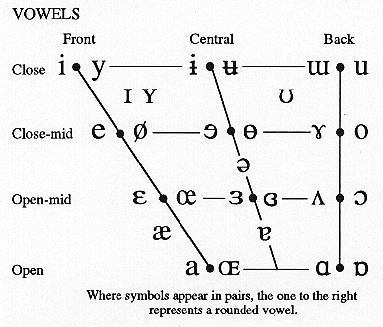Lesson I.B: Vowels
This should be the last HUGE lesson we’ll have – after this things shouldn’t take as long to explain. :-) If you haven’t yet read through the lesson on Consonants (Lesson I, Part A), please go back and read it before this lesson. Those of you that have read it might want to review it, considering how long ago that was....Be sure to review the chart of ASCII equivalents for the consonants, also. VowelsYou’ll recall that consonants are grouped according to certain “dimensions”: Place of articulation, manner of articulation, etc. Vowels can also be grouped according to the dimensions along which they vary. The Language Construction Kit lists these dimensions as Height, Frontness, Roundedness, Length, Nasalization, and Tenseness (How to Create a Language lists a few other dimensions as well, but we won’t go into those). The first three are the most important for “defining” a vowel; for example, if I mention the “high front unrounded” vowel, you’d all know I was talking about the “long e” sound in the word “sea”, right? :-) Well, once this lesson is over, you’d know that. You’d also know how to tell me what vowel you’re thinking of by defining those three features. So let’s start by learning what these features mean. HeightHow high is the tongue – i.e., how close to the roof of the mouth? This is usually divided into three positions, quite creatively named “High,” “Mid,” and “Low.” :-) Say “Bee” or “You.” That is High. Say “Cat” or “Father.” That is Low. Say “Say” or “Show.” That is Mid. FrontnessWhat part of the tongue is involved; that is, what part is raised or lowered? Is it the part close to the front of the mouth, the back, or the center? These are ever-so-cleverly classified as “Front,” “Central,” and “Back.” Front vowels are heard in “Bee,” “Snake,” and “Cat.” Back vowels are heard in “You,” “Show,” and “Father.” English has only two (some would lump them together and say only one) Mid vowels. Essentially, it’s the same sound but is classified as to whether it’s used in a stressed or unstressed syllable. For stressed syllables, the Mid vowel is that which you hear in “Shut Up.” The same sound, in an unstressed syllable, is the famous “Schwa Sound,” which all English vowels very sneakily mutate into whenever you don’t bother to put syllable stress on them. It’s the sound of the first syllable in “about,” for one example. RoundednessIn pronouncing these vowels, your tongue can’t do it all alone; the position of the lips is also a consideration. Compare “See” and “Sue.” Both have High vowels; “See” has a Front vowel and “Sue” a back vowel. What else differentiates them? It’s the lip-rounding; for “See” you pull the corners of your mouth back tightly while for “Sue” you round them into a nice little “O”. In English, curiously, only our back vowels are rounded, but front vowels can be rounded as well, and you’ll hear rounded front vowels in words like French “tu, feu” and German “du, hören.” (Respectively, that’s a High Front Rounded followed by a Mid Front Rounded in each language.) You can also have un-round back vowels, although English doesn’t. (Check out the reading assignments at the beginning of the lesson for other examples of languages that use sounds not found in English.) TensenessEnglish vowels often come in pairs: a tense version and a lax version. The difference is in the tension of the tongue muscle; there’s also sometimes a slight difference in height or length of the vowel. Tense vowels are higher, sometimes longer, and more tense than lax vowels. It’s easiest to see this contrast by looking at the vowels: “Seat” is tense, “Sit” is lax. “Boot” is tense, “Put” is lax. “Rake” is tense, “Wreck” is lax. LengthIn some languages vowels contrast between “Long” and “Short” based on the amount of TIME spent on them; generally a Long vowel is pronounced twice as long as a Short vowel. Length is a feature in Latin, Greek, Sanskrit, and Old English, for example. Some languages even have more than two degrees of length! In notation, long vowels can be differentiated from short vowels by doubling them (/aa/ for a long vowel, /a/ for a short vowel) or by writing a colon (:) after them (/i:/ for a long vowel, /i/ for a short vowel). Nasalization: Anytime a vowel is followed by a nasal consonant (n, m, N), it tends to change its sound a little. Some languages, notably French, use the nasal-sounding vowel without the nasal consonant (in French, though the consonant is written, it’s not pronounced; just the nasalized vowel is pronounced). You can hear nasalization in the difference between “Pit” and “Pin” or “Wet” and “When” or “Cat” and “Can” – the nasalized vowel tends to raise a little. Oh look! More unfamiliar phonetic symbols in the diagram! Don’t worry…we’ll explain those now. Here’s the IPA’s chart of all humanly possible vowels:  Not all of these are found in English, of course. In the diagram you can see the ones that are – you can also click on them to hear how they sound! Or hear them in these words:
Here, now, is our chart of all the vowels with their IPA symbol as in the graphic above and the diagram, an example of their usage, description of their features, and most importantly, the way we’ll write that sound in this class.
Your next assignment will follow shortly... | |||||||||||||||||||||||||||||||||||||||||||||||||||||||||||||||||||||||||||||
Aucun commentaire:
Enregistrer un commentaire